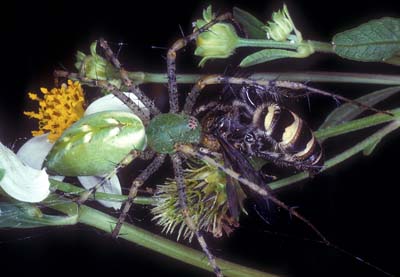
Adult green lynx spider, Peucetia viridans, with captured
wasp.
(Photographer: James E. Lloyd, University of Florida)
The female usually produces one egg sac per year during September or October. Once constructed, the female spider will guard her egg sac constantly and vigorously by hanging upside down under it. Each egg sac will contain approximately 25 to 600 eggs, which are bright orange in color.
This spider is active during the day, and can leap from place to place. Green lynx spiders are found on low shrubs and herbaceous vegetation throughout the United States.
This species feeds on various insects and other small arthropods.
Images
To save the Web-optimized images shown below to your hard drive:
|
Click to access Display and Print quality images. |